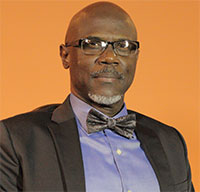The international Climate Change regime (Part 1)
By Rear Admiral (Rtd.) Gary A. R. Best
Presidential Advisor on the Environment

THIS series sets out to determine why climate change adaptation finance (CCAF) is not available to meet the climate change adaptation (CCA) requirements of small developing states (SDS). We believe that, given the numerous conferences that focused on SDS over the decades, the recognition that climate change is a development SDS negative and real possibilities that some SDS are at risk of losing their entire economies lend to the conclusion that the difficulties surrounding CCAF flows to SDS merit continuous research to identify solutions. I propose to explore this question of climate change financing for SDS through a series of articles.
THE PROBLEMATIC
Notwithstanding decades of conferences and summits, embedded financial provisions in conventions and pledges, SDS, as a whole, have been unable to access sufficient CCAF to meet their CCA needs. In the result, their nation states and economies have become more susceptible to sea level rises and vulnerabilities, exacerbating their economic, social and environmental conditions.
It is important to recognize some important shifts over the period leading up to United Nations Framework Convention on Climate Change (UNFCCC) 1992. In the 1940s, international environmental emphasis focused on preserving the resources of the natural environment (Sands). However, by the 1950s, the focus had changed to preserving the oceans’ resources (Sands). In the 1960s, 70s and 80s, the emphasis was on preserving living and non-living resources in the earth’s biosphere, with particular attention to ozone depletion (Birnie and Boyle). By the time of the UNFCCC in 1992, the international environmental scientific community had solidified its position that the danger to the earth’s climatic existence lay in preserving the biosphere. Hence UNFCCC’s focus on reducing greenhouse gas (GHG) emissions from fossil fuels, which damage the earth’s atmosphere, and negligible emphasis on reducing emissions from deforestation and forest degradation (REDD+).
The objective of the UNFCCC (the Convention), adopted in 1992, is to stabilize GHG concentrations in the atmosphere at a level that would prevent dangerous human interference with the climate system (UNFCCC 1992: Art 4). A key principle under the Convention is the provision of new and additional financing that would flow from developed states to developing states to combat climate change, in accordance with their common but differentiated responsibilities and respective capabilities (UNFCCC 1992, Art 3 & 4). The principal instrument determining the obligations of the Parties to the UNFCCC in relation to emissions’ reductions is the Kyoto Protocol (1998). Under this Protocol, developed states listed at Annex 1 of the UNFCCC (1992) agreed to quantified emissions’ limitations and reductions (stipulated at Annex B of the Protocol) in order to promote sustainable development (Kyoto 1998). Consequently, developed and developing states agreed to hold the increase in global temperatures below two degrees Celsius, or one point five degrees Celsius above pre-industrial levels (FCCC/ Decision 1/CP.16).
However, according to International Panel on Climate Change (IPCC), the concentration of GHG emissions in the earth’s atmosphere continues to rise over the past three decades, and will continue its upward growth, despite current mitigation actions (IPCC 2007) that also allow monitoring and measurement of emissions’ reductions across some nations. Nonetheless, the IPCC (2014) projects, with high confidence, an increase in global temperatures beyond 2o Celsius (IPCC 2013).
Under the Convention, financial institutions serve to coordinate the activities relating to the provision of climate change financing (CCF). In this regard, a Standing Committee on Finance (SCOF) assists the COP in coordinating the delivery of climate finance within and outside the Convention. The Global Environmental Facility (GEF), the Green Climate Fund (GCF), and the Adaptation Fund (AF) are the principal financial institutions established to provide CCAF to SDS. The Conference of the Parties (COP) guides the activities of the GEF, which is the only operating fund within the Convention. The members of the Development Assistance Committee of the Organization for Economic Cooperation and Development (OECD) replenish the GEF every four years. However, most of this funding targets calculable mitigation projects, as opposed to adaptation measures (OECD 2012).
According to Kate Miles, GEF funding is insufficient to ensure sustainable financial flows to meet incremental costs of agreed global environmental benefits (GEF 2011). Additionally, Miles op cit argues that Agenda 21 recognized the need for additional funding and makes a case for innovative financing to supplement the CCAF deficit. These innovative financial ventures include debt-for-nature swaps, conservation trust funds, tourism-related taxes and fees, tradable quota systems, and private sector payment for environmental services. Further, there is an international call to provide funding beyond the GCF, in order to drive green growth (GGGI 2012).
Even though developed nations were to provide new and additional resources (UNFCCC 1992: Art 4) using the ‘fast start ‘mechanisms (Copenhagen Accord), to the tune of US$30 billion, there are no means to determine if indeed such funds would be new and additional, let alone which agency would manage such funds (GGGI 2012).
Meanwhile, OECD (2012) has also recognized that mobilizing US$100 billion per year by 2020 requires funds from private, public, multilateral and bilateral sources. Moreover, the GCF, which is intended to operate as a coordinating mechanism for all financial flows from diverse sources (FCCC/2010 Decision 1/CP.16), is now operational, and details relating to size, governance, powers, rules and members are still being completed.
The Least Development Countries Fund (LDCF), managed by the GEF, is a fund for adaptation measures geared towards supporting projects that attend to urgent and immediate adaptation needs of the least developed countries (OECD). In addition, the GEF also manages the Special Climate Change Fund (SCCF), which finances activities such as adaptation measures and transfer of technologies that are complimentary to those funded by the GEF.
On the other hand, An Adaptation Fund Board supervises the Adaptation Fund, which receives its revenue from a 2% levy of certified emissions’ reductions (CERs) earned for clean development mechanism (CDM) projects. However, revenue provided for adaptation depends on the quantity of CERs issued and the price they attract (OECD). Consequently, there is a connection between financing adaptation measures and the efficiency of mitigation efforts through the CDM.
There is no doubt that Guyana, like many other SDS, is anxious to tap into convention-obligated financing to drive its green growth, green economy and its green state.
In the next article, I will examine the Climate Change Finance Regime. (Comments can be sent to towardsagoodlife@gmail.com)
Mr. Gary A. R. Best is a retired Rear Admiral and former Chief of Staff of the Guyana Defence Force. He is an Attorney-at-Law and the Presidential Advisor on the Environment. He is a PhD. candidate at the University of the West Indies. He holds a BSc. in Nautical Science (Brazil) and Masters’ degrees from the University of the West Indies and the University of London. He is also an alumnus of the National Defence University and Harvard Kennedy School. His research areas include climate change governance, climate change finance, international relations and environmental law.



.jpg)










